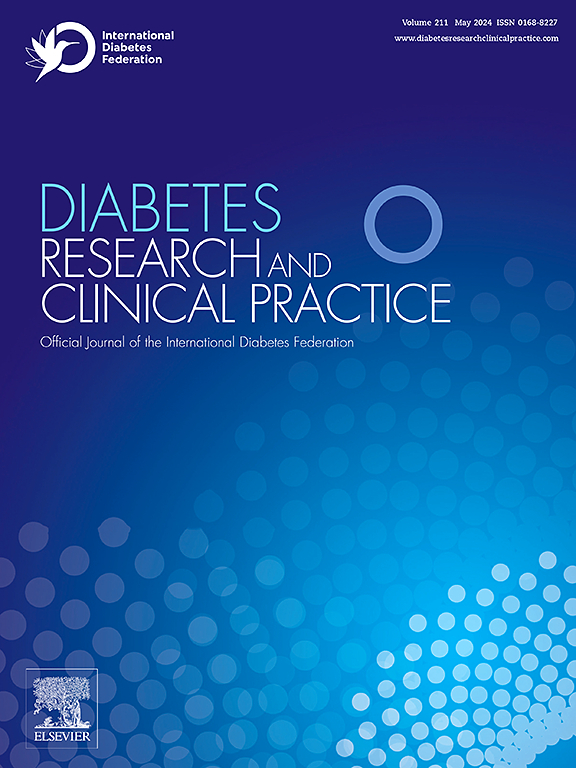Evaluation of cardiovascular risk according to the 2019 ESC/EASD guidelines in type 1 diabetes mellitus patients: A population-based survey study
IF 6.1
3区 医学
Q1 ENDOCRINOLOGY & METABOLISM
引用次数: 0
Abstract
Background
The 2019 European Society of Cardiology and European Association for the Study of Diabetes (ESC/EASD) recommendations classified cardiovascular disease (CVD) risk in diabetes mellitus (DM) patients. The assessment and stratification of CVD risk were essential for identifying individuals with a very high risk of cardiovascular disease (CVD) and implementing glycemic control regimen with clear cardiovascular benefits. This research aim to evaluate the ratio of very high CV risk among patients with type 1 diabetes mellitus (T1DM) in mainland China.
Methods
This was a cross-sectional screening study from Jan 01, 2020 to Dec 30, 2022. Basic information such as disease duration, body mass index (BMI), target organ damage (including atherosclerotic heart disease, impaired renal function, left ventricular hypertrophy, and retinopathy) were collected from outpatients by trained physicians. According to the 2019 ESC/EASD guidelines, we identify T1DM individuals with a “very high CVD risk” and others were categorized into the “else” group.
Results
A total of 38,260 participants from 1,669 hospitals in mainland China were enrolled from 2020 to 2022, of which 54.81 % of T1DM patients were at very high CV risk category. The proportions of very high CVD risk in T1DM patients were highest in the Northeast region (72.70 %), followed by the Southwest region (69.99 %), and the Central region (54.41 %), while it was the lowest proportion in the Southern region (47.03 %). The proportion of very high CVD risk among T1DM patients increased with age and BMI, with 33.61 % in those under 35 years old, 59.57 % in those between 35 and 65 years old, and 70.80 % in those over 65 years old (P < 0.0001). Males and smokers showed an increased proportion of very high CVD risk in T1DM patients (P < 0.0001).
Conclusions
This was the largest cross-sectional screening study to assess the CVD risk in T1DM patients in mainland China. The CVD risk among Chinese DM patients has reached a critical level which may necessitate the comprehensive strategies for the control and management of CV-related risk factors, such as blood pressure, BMI, and lipids in DM patients, to effectively reduce the incidence of CVD events and death.
根据2019年ESC/EASD指南评估1型糖尿病患者心血管风险:一项基于人群的调查研究
2019年欧洲心脏病学会和欧洲糖尿病研究协会(ESC/EASD)建议对糖尿病(DM)患者的心血管疾病(CVD)风险进行分类。心血管疾病风险的评估和分层对于识别心血管疾病(CVD)高危个体和实施具有明显心血管益处的血糖控制方案至关重要。本研究旨在评估中国大陆地区1型糖尿病(T1DM)患者中非常高CV风险的比例。方法2020年1月1日至2022年12月30日为横断面筛查研究。由训练有素的医生收集门诊患者的基本信息,如病程、体重指数(BMI)、靶器官损伤(包括动脉粥样硬化性心脏病、肾功能受损、左心室肥厚和视网膜病变)。根据2019年ESC/EASD指南,我们确定T1DM患者具有“非常高的心血管疾病风险”,而其他人则被归类为“其他”组。结果2020 - 2022年共纳入中国大陆1,669家医院的38,260名受试者,其中54.81%的T1DM患者属于非常高CV风险类别。T1DM患者CVD高危比例以东北地区最高(72.70%),西南地区次之(69.99%),中部地区次之(54.41%),南部地区最低(47.03%)。T1DM患者中CVD高危人群的比例随年龄和BMI增加而增加,其中35岁以下占33.61%,35 ~ 65岁占59.57%,65岁以上占70.80% (P <;0.0001)。男性和吸烟者在T1DM患者中心血管疾病风险极高的比例增加(P <;0.0001)。结论:这是中国大陆最大的评估T1DM患者CVD风险的横断面筛查研究。中国糖尿病患者的心血管疾病风险已达到临界水平,需要采取综合策略控制和管理心血管相关危险因素,如糖尿病患者的血压、BMI和血脂,以有效降低心血管事件的发生率和死亡率。
本文章由计算机程序翻译,如有差异,请以英文原文为准。
求助全文
约1分钟内获得全文
求助全文
来源期刊

Diabetes research and clinical practice
医学-内分泌学与代谢
CiteScore
10.30
自引率
3.90%
发文量
862
审稿时长
32 days
期刊介绍:
Diabetes Research and Clinical Practice is an international journal for health-care providers and clinically oriented researchers that publishes high-quality original research articles and expert reviews in diabetes and related areas. The role of the journal is to provide a venue for dissemination of knowledge and discussion of topics related to diabetes clinical research and patient care. Topics of focus include translational science, genetics, immunology, nutrition, psychosocial research, epidemiology, prevention, socio-economic research, complications, new treatments, technologies and therapy.
 求助内容:
求助内容: 应助结果提醒方式:
应助结果提醒方式:


